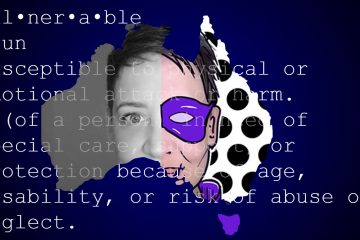When I think of Goldilocks, I think of the golden-haired-furniture-destroying-burglar from the fairy story who wasn’t prepared to settle. When Papa Bear’s porridge wasn’t for her, she moved onto Mama Bear’s. When she found that not exactly to her taste, she abandoned it mid-spoonful, and moved onto Baby Bear’s porridge.
It may not have been ethical (let’s face it, she broke into the Bear’s house, shattered a chair, ate their morning meal and had a little snooze while she was at it). But you have to admire her resolve; Goldilocks had a plan. She knew precisely what she wanted. She understood exactly what she needed: everything had to be just right.
What I’ve come to understand (particularly in the last few years) is that having epilepsy is much like being Goldilocks. I’ve had this condition for 30 years and although I can’t control it, by using the porridge-pilfering-blondie’s mindset, it can be managed.
About 4-years ago I fell upon the analogy that having a chronic long-term health condition is very much like a full-time job:
- You need training to learn how to manage it
- If you don’t work hard enough at it there’s a price to pay
- Every now and again, it might give you something extra to deal with (overtime if you like) but you can manage if a work/life balance is put into place
This is, in and of itself, The Goldilocks Method.
I’d be a big ol’ fibber if I were to say now I get every aspect of this right, every step of the way. I don’t, far from it. Time doesn’t make you an expert, how can it? This is epilepsy we’re talking about: an erratic, sporadic and entirely unpredictable condition. But the Goldilocks Method helps me manage my life with epilepsy.
Take bad days.
Those days where all I feel capable of doing is staying in bed, in my PJs, watching TV and drinking (what could be considered an extraordinary amount of) tea. There’s usually a nagging voice at the back of my head saying, ‘get up, don’t waste the day’.
I try to think to myself What Would Goldilocks Do?
She’d weigh up not just what she wanted, but what she needed, at that time. Although she recognises the benefits and advantages of staying in bed, Goldilocks isn’t a hedonist. Equally, although she recognises the benefits and advantages of getting up, out and about, she’s no sadist. She’s all about what’s just right. More importantly though, it’s about what’s just right for her.
When I’m having a PJ-wearing-drinking-tea-in-bed day and employ The Goldilocks Method, it generally works out at roughly 24-hours. Following that (if there are any left) the chocolate biscuits are returned to the cupboard; I get up and (pre-lockdown) go out and about. For me it’s just the right amount of time-out, not too much, not too little.
I’ve found the simplicity of the Goldilocks Method is helpful in most situations, not just for weighing up bad days (or choosing the ideal chair).
In February 2017 I stopped working. What I was unprepared for was how it was going to affect me mentally. I’d become used to a life filled with seizures and the knock-on effects of fatigue. The isolation I felt almost immediately was entirely unexpected and difficult to shake. I didn’t recognise how very depressed and anxious I had become, or that I was deteriorating.
One afternoon in July that year, I’d called G. and asked him to come over. I’d said, ‘I wasn’t feeling right’, but (deep down) I was sure I was about to have a generalised seizure. I don’t remember what happened in my flat that day. Since G’s explained I screamed loud blood-curdling screams, as if I were being murdered. He just knew it wasn’t really me; he knew he couldn’t calm me down. He ‘got’ that he was going to have to ride it out and hoped that the neighbours hadn’t (and wouldn’t) call the police. As soon as he was able to, G. got me in the car & drove me to A&E.
I spent a week in hospital after having at least one generalised seizure along with several, (what the A&E doc at the time called) pseudo-seizures. That was like being told I was faking. No, it’s worse in that a doctor was saying it. These were seizures; I have epilepsy, of course these were seizures. But on and on they went. My arms (just my arms) kept flailing, waving and swinging wildly, like I was Morris dancing.
I understand now they were dissociative seizures; it was anxiety and stress, not epilepsy (directly) that caused them. It’s common for stress in people with epilepsy to manifest as dissociative seizures. It almost makes sense; it’s what our bodies know how to do. Even as recently as the last 8-months I can find another episode that’s similar. In November ‘19 I called 999 because (as with G. in 2017) I felt I was experiencing my generalised seizure aura.
A certain level of anxiety is a good thing. It’s anxiety which activates the fight or flight instincts; if ignored completely, we’d put ourselves at too-close-to-the-edge levels of risk unnecessarily, every day. It’s about finding balance and I can attest to how difficult it is. But taking deep breaths helps (cheesy but true). And thinking while in those tense situations (and even sneaky situations which don’t seem stressful but are) ‘What Would Goldilocks Do?’ I can look at whether my reaction is way too much, not reactive enough or just right.
It’s not just me who benefits from the brazen-yellow-haired-home-invader’s philosophy either, it’s everyone around me.
I’ve had this condition for 30 years and what I’ve come to value most is my independence. I live alone and until it’s deemed impossible to do so, it’ll remain this way. 95% of the time, it’s not even discussed, why would it be? 95% of the time I’m a healthy, strong, relatively coherent 41-year old woman who rocks at life. Everyone’s happy.
What has caused tension is the other 5% of the time.
I have focal impaired awareness seizures. My seizures begin in one part of my brain (focal), I haven’t got the foggiest what’s going on while they are happening (impaired awareness). One part of my brain takes a time-out: like something, somewhere hit ctrl + alt + delete. The other parts are then determined to carry on as if nothing malfunctioned. All the operational brain cells are in there shouting: ‘pull it together, lads. Do something, the fairies have got her, do what you can, maintain normal service’.
If I’ve fallen and hit my head, my family and I have a system where I text to tell them. I don’t find this difficult, checking in with my family after an injury makes sense. It’s not an issue and it reassures everyone. Where I struggle is the 95% of the time when life is fine and dandy, it’s harder to check in on these days. On these days it feels like an invasion of privacy.
Over the years, we’ve worked together to strike a happy, healthy balance; we do this using the Goldilocks Method. We all make efforts not to do too much, or too little; the balance has to be just right, for me to be safe and for them to be comfortable. But don’t just take it from me:
Hey, I’m G; the one from the article you’re reading right now.
Jo asked me to give a little insight as a ‘someone’ who’s there for a person managing their epilepsy. Perhaps you’re reading this as that ‘someone’ yourself, perhaps you’re the one managing your condition and struggling with finding the balance between your independence and the support being offered by your own family and ‘G’?
Well hopefully this is for you both.
When I first met Jo, I thought I knew about epilepsy; “flashy lights result in writhing on the floor”, right? It’s the typical preconception most people have who’ve never experienced the condition up close and personally. When Jo first told me, she had epilepsy I didn’t really understand at the time how varied the condition could be, the implications seizures could have or the effect on daily life around those seizures. I learned fast but as a typical guy I tended to focus on practical support – pragmatic and highly logical but occasionally lacking empathy for how my actions made Jo feel.
My over-attentiveness or trying to manage things for Jo sometimes made her feel monitored or surveilled and resulted in several conflicts early in our friendship. What made it difficult was that it only ever came from a place of deep care; I didn’t want to see my friend get hurt but unintentionally I was sometimes ‘killing with kindness’. I had to learn to respect that Jo is fiercely independent and had been managing her condition for a long time before I showed up.
I just needed to be there when I was needed.
Part of ‘being there’ involves accepting that I can’t always solve things or that Jo may get hurt during a seizure – but it’s not my condition to manage. Sometimes I just need to listen and to be there not too little…and not too much.
It’s still a fine line between getting mad at them for not allowing me my independence and loving them for loving me so much they’d drop everything and drive over. But now it’s a battle I choose to let rage inside, because when they stop badgering me, is when I’ve lost them. If maintaining my independence means checking in on WhatsApp so the world (or at least my Mum) knows I’m alive, I’m happy to do so.
The Goldilocks Method is applicable to pretty much all aspects of life with (or without) epilepsy; it’s simple and allows the opportunity to take a few moments to think about your decisions. It doesn’t matter if I’m deciding whether to trial a new, higher dose of medication, or if I’ve had a rough night and can’t face the day. By utilising the ‘What Do I Want’ vs ‘What Do I Need: What’s Just Right for Me, Right Now?’ mantra life’s a little easier.
Because having epilepsy is like being Goldilocks: you can’t have too much, you can’t have too little; everything has to be just right.



1 Comment
Michele Finch · September 27, 2020 at 10:35 AM
I managed OK for years with life; marriage, kids, running a business. In 2013, my “nearly ex” Alcoholic husband and, then, teenage Sons’ father and my business partner, carried on drinking and left me out cold as/after I had a Seizure due to immense stress and pressure, partly caused by him. I am very proud of my youngest Son who came back home, put me in the Recovery Position and dialled 999. I spent 7 days in Hospital as I suffered, not only Epileptic Seizures (I am now 59 and had Epilepsy since I was 11) but I was the nearest you can be to a Nervous Breakdown without actually having one… I have never recovered. I keep having Seizures. We Epileptics are all so unique, that’s why our brains are all so different. Several seizures and Hospital admissions later on over the years, here I am in bed again, released on Thursday x 48 hours in Hospital – Seizures and Covid. The DWP need to be educated about how Epilepsy affects everything – confidence, memory, ability to work and more. When I came to this time around, I didn’t have a clue where I was and it’s taken me days to feel even just a slightly bit more “normal”. Everything is absolute and utter stress – vicious circle – can’t win….,